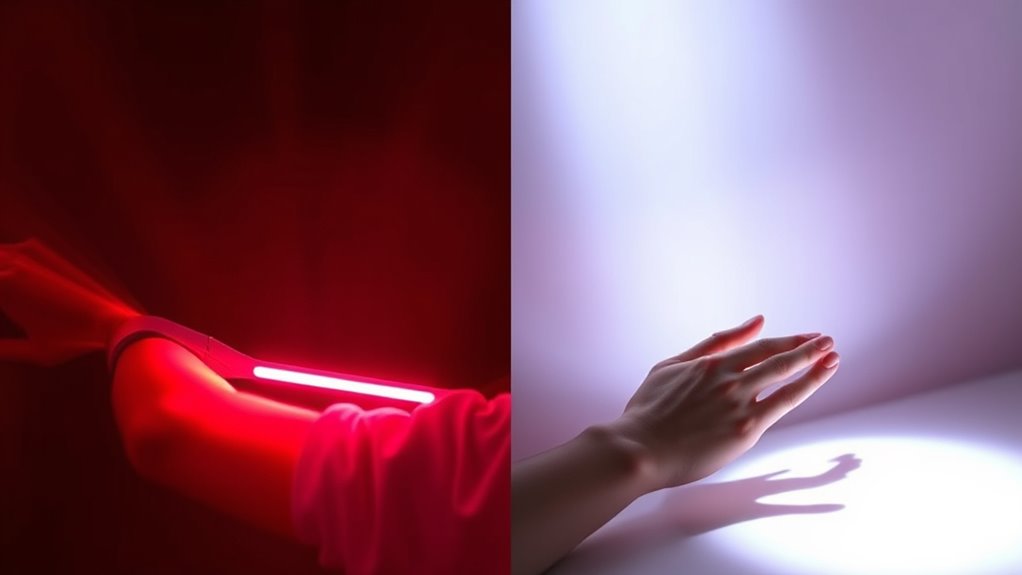Red and near-infrared light therapies are effective biohacking tools that use specific wavelengths to boost cellular repair, reduce inflammation, and improve health. Red light (620-750 nm) targets superficial skin, promoting skin health and wound healing, while near-infrared (750-1200 nm) penetrates deeper into muscles and joints for pain relief and tissue recovery. Understanding their differences helps you optimize your health routine — discover how each can work for you as you explore further.
Key Takeaways
- Red light (620-750nm) mainly targets superficial skin tissues, promoting skin health, collagen production, and wound healing.
- Near-infrared light (750-1200nm) penetrates deeper, supporting muscle recovery, joint health, and brain function.
- Red light is ideal for enhancing skin appearance and reducing inflammation at surface levels.
- Near-infrared therapy benefits chronic pain management, cellular repair, and neuroprotection through deeper tissue interaction.
- Both wavelengths operate via photobiomodulation but differ in tissue penetration and specific health applications.

Biohacking with light has become an innovative way to optimize your health and boost your daily performance. One of the most exciting methods is photobiomodulation therapy, which uses specific wavelengths of light to stimulate cellular processes. By understanding the differences between red and near-infrared light, you can harness their unique benefits to improve recovery, reduce inflammation, and enhance overall well-being. Both types of light are delivered through LED devices, making it accessible and convenient for daily use. The LED light benefits are significant because they allow targeted therapy without invasive procedures, and they are safe for regular application.
Harness red and near-infrared light for safe, targeted, and effective health optimization at home.
Red light typically falls within the 620-750 nanometer range. When you use red light therapy, it penetrates your skin to reach the superficial layers, making it ideal for skin health, wound healing, and reducing inflammation. It’s known to stimulate collagen production, which can improve skin tone and elasticity. You’ll notice that red light therapy can also help with muscle recovery after exercise by increasing blood flow and decreasing soreness. The LED light benefits here are clear: it’s non-invasive, easy to use, and effective for boosting your skin’s health and healing processes.
Near-infrared light, on the other hand, operates at a longer wavelength, typically between 750 and 1200 nanometers. This allows it to penetrate deeper into your tissues, reaching muscles, joints, and even your brain. When you incorporate near-infrared light into your routine, you may experience enhanced mitochondrial function, which is essential for energy production at the cellular level. This deeper penetration makes near-infrared therapy especially advantageous for managing chronic pain, improving brain function, and promoting overall cellular repair. The LED light benefits of near-infrared therapy include its ability to promote neuroprotection and accelerate recovery from injuries by reaching tissues that red light cannot. Additionally, understanding the mechanisms behind cellular energy production can help you better grasp how these therapies work on a fundamental level.
Both red and near-infrared light therapies work through photobiomodulation, a process where light energy influences cellular activity. You’ll find that the key difference lies in their depth of penetration and specific applications. While red light is excellent for skin and superficial tissues, near-infrared targets deeper structures, making it versatile for a range of health concerns. Incorporating these therapies into your routine can be simple and effective, especially with modern LED devices designed for home use. By understanding the distinctions and benefits of each, you can tailor your biohacking strategies to optimize your health, recover faster, and maintain higher energy levels throughout the day.
Frequently Asked Questions
Can Light Therapy Improve Mental Health Conditions?
You might find that light therapy can positively impact your mental health, offering mood enhancement and a cognitive boost. By exposing yourself to specific wavelengths of red or near-infrared light, you stimulate cellular processes that support brain function. This non-invasive approach can help reduce symptoms of depression and anxiety, making it a promising tool for improving overall mental well-being. Give it a try and see how it benefits you.
How Does Light Exposure Impact Sleep Quality?
Did you know that exposure to blue light before bed can reduce melatonin production by up to 23%? Light exposure considerably impacts your sleep quality by influencing circadian rhythms and melatonin regulation. When you get insufficient or poorly timed light, your sleep may become fragmented or delayed. To improve sleep, limit evening light exposure and seek natural light during the day, helping your body maintain a healthy sleep-wake cycle.
Are There Any Risks Associated With Red and Near-Infrared Light Therapy?
You might wonder if red and near-infrared light therapy has risks. While generally safe, you should watch for potential skin irritation or eye safety concerns. Overexposure can cause discomfort or damage, especially if you look directly into the light without protection. It’s best to follow recommended guidelines and consult a professional to minimize risks and safely enjoy the benefits of this therapy.
What Are the Best Devices for At-Home Light Biohacking?
When choosing at-home light biohacking devices, you want options that are effective and affordable. Look for devices with proven wavelength outputs and good user reviews to guarantee effectiveness. Consider cost because quality devices can vary widely in price, so balance your budget with features you need. Brands like Joovv, MitoRed, and Red Light Rising offer reliable options, but always research to find one that best fits your goals and budget.
How Long Should I Expose Myself to Red or Near-Infrared Light Sessions?
For ideal exposure time, aim for 10 to 20-minute sessions with red or near-infrared light. Your session duration depends on your goals and device strength, but starting with shorter periods helps prevent overstimulation. You can gradually increase exposure time as your body adapts. Consistency is key, so aim for daily or every other day sessions to maximize benefits. Always listen to your body and adjust accordingly.
Conclusion
By now, you see how red and near-infrared light can boost your health. Did you know that some studies show red light therapy can improve mitochondrial function by up to 45%? That’s a huge leap for energy and recovery. So, whether you’re aiming for better sleep, faster healing, or enhanced performance, experimenting with light biohacking could be worth a shot. Just remember, small changes can lead to big results in your wellness journey.








